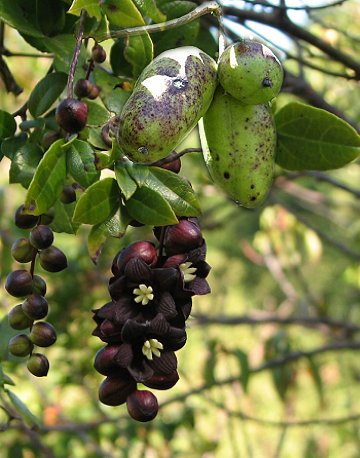
|
|
Zabala
(Lardizabala biternata). Flowers and
fruits.
|
Zabala - Lardizabala biternata
Lardizabala is a monotypic genus of flowering plants. These plants are evergreen lianas, native to temperate forests of central and southern Chile. The sole species is Lardizabala biternata Ruiz & Pav, known as Coguil, Cogüilera, Coiye, Coille, Voqui cógüil, or Voqui coille, in Chile, and known as Lardizabala or Zabala fruit in English. It is grown for its edible fruits (called coguil or cógüil in Mapuche language) and ornamental flowers.
The genus is dedicated to Miguel de Lardizábal y Uribe [es], a Spanish statesman from the 18th century.
Lardizabala biternata is a
copiously-leaved, evergreen, climbing shrub ( liana) with deep green foliage producing stems about 3.5 metres long that twine around other plants for support.
It is Cold hardy to -7 degrees Celsius and is frost tender.
In flower from December to February. The species is monoecious (individual flowers are either male or female, but both sexes can be found on the same plant). The plant is not
self-fertile, so two plants might required for the plant to fruit, similar to its cousins the Akebia vines.
A vigorous evergreen climber, with ternate, biternate, and triternate leaves. The three, six, or nine leaflets are of hard texture, each 2 to 4 in. long, the middle one of each trio the largest. They vary much in outline, but are mostly ovate, the lateral ones more or less oblique, and often sessile, margins shallowly crenate, with here and there a sharply pointed tooth; leaf-stalks covered with short brown hairs.
Flowers functionally unisexual; males 3⁄4 in. across, produced in drooping spikes 3 to 4 in. long from the leaf axils; the sepals form the most effective part of the flower, being broadly ovate, fleshy and dark chocolate purple; petals small, narrow, white and mealy. Female flowers on slender stalks 1 in. long, solitary in the leaf-axils, rather larger than the
male.
Fruits sausage-shaped, 2 to 3 in. long; seeds flattened and about the size of small peas.
Suitable for: light (sandy) and medium (loamy) soils and prefers well-drained soil. Suitable pH: mildly acid, neutral and basic (mildly alkaline) soils. It can grow in semi-shade (light woodland). It prefers moist soil.
The fruit is sweet, pulpy, and edible, raw or
cooked. Is obtained from the wild plant, and considered to be a delicacy in
Chile. The fruit is sold in the local markets in Chile and Peru. Also of interest value because of its sausage-like deep purple fruits.
A cordage is made from the tough fibre in the stems. The stems, which grow to enormous lengths in Chile, are dried and used as ropes. They would probably yield a good, tough cordage fibre.
A very ornamental plant, often grown in
garden.
Source:
https://en.wikipedia.org/wiki/Lardizabala
https://tropical.theferns.info/viewtropical.php?id=Lardizabala+biternata
https://pfaf.org/user/Plant.aspx?LatinName=Lardizabala+biternata
https://www.treesandshrubsonline.org/articles/lardizabala/lardizabala-biternata/
